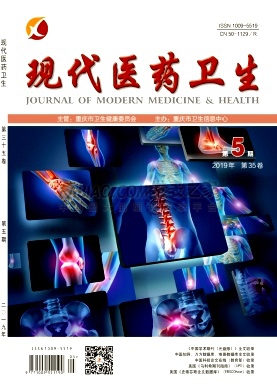INTRODUCTION
Bertolotti first described the lumbosacral transitional vertebrae in 1917 and put forward a concept of Bertolotti syndrome[1].It is believed that the unilateral or bilateral transverse process of the terminal lumbar vertebrae is enlarged and broadened due to abnormal development, and sometimes the enlarged transverse process forms pseudarthrosis or fusion with the deformity is related to chronic low back pain, lower limb pain and other is the earliest report about lumbago caused by lumbosacral transitional recent years, different scholars[2-6]reported that the incidence of lumbosacral transitional vertebrae was different in different people, but in people with lumbar pain diseases such as lumbar disc herniation, the incidence of transitional vertebrae was significantly increased, and the overall incidence was higher[7-9].Lumbar vertebrae as a whole system,the pathological changes and morphological abnormalities of any segment will lead to changes in the mechanical morphology of the whole system, and then lead to an increase in the probability of injury in a certain part, so the study of transitional vertebrae has a very important clinical significance.
For patients with lumbar sacral vertebrae, the analysis of the maximum load of each vertebral segment and the trend of mechanical changes is the basis of clinical treatment of low back pain caused by lumbar vertebrae, but at present, there are few mechanical simulation on the mechanics of lumbar pedicle in adolescent patients with transitional vertebrae are even less[10-11].In this study,the CT images of adolescent patients with lumbar sacralization were selected to obtain three-dimensional finite element models of lower lumbar vertebrae of adolescent sacral lumbar vertebrae, andtheir stress and strain distribution and mechanical characteristics were analyzed, so as to provide carrier and basis for further study of mechanical changes and bone fatigue coefficient of lower lumbar vertebrae in transitional vertebrae patients.
MATERIALS AND METHODS
Design
A three-dimensional finite element analysis.
Time and settings
The experiment was conducted in 2019 at the Digital Medical Center of Inner Mongolia Medical University.
Subjects
One patient with lumbar sacral vertebrae was selected, a 16-year-old male of Han nationality, with a body mass of 60 kg, height of 1.75 m and body mass index (19.59 kg/m2).The volunteer had no previous history of lumbar trauma and related obtain written informed consent from patient and his research was approved by the Ethics Committee of Inner Mongolia Medical University (approval number YKD) on March 5, 2018.
Methods
Acquisition of two-dimensional data
In this study, the Lightspeed dual-source 64-slice spiral CT (GE, USA)was used to scan the upper edge of the L1vertebra to the lower edge of the L5vertebra using the volume scan mode.Lie on your back with your head parameters: slice thickness 5 mm, layer spacing 5 mm, scanning field 20 cm2, matrix 512 × 512, standard algorithm the end of the scan, the data is divided into layer thickness 0.625 mm, layer spacing 0.625 mm and saved in DICOM format (Figure 1).
Figure 1| Mimics 21.0 software interface of lumbosacral transitional vertebrae in adolescentsNote: import CT data into software for 3D reconstruction.
3D reconstruction of 2D data
import the original DICOM data into (Materialise Belgium), through the steps of threshold setting, image segmentation, region growth, image filling and so on, the L4-sacrum is segmented and smoothed, and then the Mask, of each vertebra is obtained through the Calculate3D module to get the 3D image of the use the 3-matic software in software to optimize the model and export it in STL format (Figure 2).
Reconstruction of 3D solid model
Figure 2| Geometric reconstruction model of lumbar vertebrae of sacral vertebraeNote: The built-in 3-matic software in software to smooth, reduce noise and repair the model.
After Mimics image extraction and 3-matic model repair, the complete vertebral models of L5and sacrum were present, the appearance of each model is close to the real vertebra,with regular vertebrae, transverse process, spinous process, upper and lower articular process and other main introducing the model into Geomagicstudio (Geomagic, USA) the model unit is first selected, which is millimeter by default, and the system automatically prompts for grid doctor this processing, the polygon model of feature and smoothness balance is the sacrum model, use the plane clipping function,retain only the part of the sacrum in contact with S1, and carefully close the clipping plane, using the grid doctor to check to avoid causing the model to be unclosed (Figure 3).
Figure 3| L5and optimized reconstruction model of lumbar sacral vertebraeNote: Use Geomagicstudio software to simplify the sacrum model, and use the plane clipping function to retain only the part of the sacrum that is in contact with S1, thereby obtaining a polygonal model with balanced features and smoothness.
Making of lumbar intervertebral disc model
The real lumbar vertebra is a complex motion system composed of vertebrae, intervertebral discs, ligaments, muscles and so on.If you want to carry out finite element analysis, the most simplified model should at least include vertebrae and intervertebral discs.It is very easy to make intervertebral disc models with Geomagic Studio shape of the intervertebral disc model made in the experiment is lifelike, showing a disk shape similar to the solid, the leading edge is thick, the trailing edge is flat, and the edge is smooth without edges and nucleus pulposus is located slightly behind the center of the intervertebral disc on the cross section and in the middle of the intervertebral disc on the coronal measurement, the relevant parameters of intervertebral disc and nucleus pulposus are consistent with the real human assembling, the intervertebral disc and adjacent vertebrae can be closely attached, the relative position of intervertebral disc and vertebra is correct, and there are no pathological manifestations such as intervertebral disc herniation, which can meet the needs offurther experiments (Table 1 and Figure 4).
Table 1 |L4/5disc and nucleus pulposus morphological parameters (mm)Item Front edge thickness Rear edge thickness Left edge thickness Right edge thickness Cross diameter Sagittal diameter L4/5 intermediate 10.67 5.96 7.84 8.03 48.03 35.4 L4/5 nucleus pulposus 6.91 4.16 4.50 4.70 27.3 17.19
Figure 4| Intervertebral disc model and sectional viewNote: Using Geomagicstudio software can be very simple to generate intervertebral disc model.
Assembly and volume meshing of lumbosacral transitional vertebrae
Through the previously described work, a high-quality triangular model of the lumbar spine and intervertebral disc was obtained, but it is not a CAD model and it needs to be further transformed into a NURBS surface solid model and exported in IGES, sat, X_T, and other formats in order for the data to be smoothly imported into the WorkBench finite element analysis software (ANSYS, USA).The specific workflow is as follows, using the L4/5disc as an example:
(1) After importing the model into Geomagic Studio, the Exact Surfaces Phase is clicked and Exact Surface is clicked.
(2) Click the Detect Curvature method and select Auto Estimate and Simplify Contour.
(3) Using the Construct Patch tool, the area was were occasional errors such as intersecting paths, different sizes of surface patches in the structure, or mismatch between the distribution pattern and the actual shape of the model, and further manual editing of the surface patches was required.
(4) Use the Move Panel function under the Move option to edit the patch.
(5) Construct the grid, click on the Construct Grid button, click on Repair Intersection Area, and check the geometry option, and use a resolution of 20 to get the model image that covers the grid.
(6) Click on the fitted surface to transform the model formed by the grid into a NURBS surface and optimize the smoothness option to further smooth the , save the NURBS surface in IGES or STEP format for the next step.
import of finite element model into WorkBench and calculations
The assembled model was imported into WorkBench as described previously[11-13].The corresponding material properties were assigned to the vertebrae, the annulus fibrosus, and the nucleus , the assembled model and properties were assigned, the mesh was defined, and the contact surface, boundary conditions, and load were loading, a 2 N·mm force was applied for the analysis and calculation under the conditions of flexion, extension, lateral bending to the left, and lateral bending to the stress and overall deformation of the model as a whole and the L5and S1finite element models were calculated when the flexion, extension, and bending moments were 2 N·mm(Table 2 and Figure 5).
Table 2 |Material parameters of the model[11-12]Elastic modulus (MPa) Poisson's ratio Cortical bone 12 000 0.29 Cancellous bone 450 0.29 Endplate 500 0.40 Nucleus pulposus 1 0.49 Fibrous ring 110 0.30
Figure 5| Loading surfaces for extension, flexion, lateral bending to the left, and lateral bending to the rightNote: The loading surface change display of the model under different loading conditions.
Main outcome measures
To analyze the mechanical properties and stress-strain rules of lumbar vertebrae under simulated normal exercise conditions.
RESULTS
A three-dimensional finite element model of lumbar sacral vertebrae was established
In this study, a three-dimensional finite element model of lumbar sacral vertebrae in adolescents was established based on the data of patients with lumbar sacral vertebrae, including 22 815 elements and 12 785 nodes (Table 3).The model is highly simulated, the geometric structure is good, the appearance of the model is close to the structure of sacral lumbar data, and has a high degree of reduction (Table 3 and Figure 6).
Table 3 |Data of lumbar vertebra model of sacral vertebra in threedimensional finite element model of adolescentsVertebral order Number of units Number of nodes Volume (mm3)L4 2 822 1 411 49 863.80 L5 3 132 1 566 67 661.42 S1 3 116 1 558 75 474.42 Sacrum 16 545 8 250 479 596.28
Figure 6| Geomagic Studio optimization, assembly, and volume meshing of the modelNote: A three-dimensional finite element model of the lumbar sacral spine of adolescents after optimization and meshing.
Stress analysis of lumbar vertebrae of sacral vertebrae under different working conditions in three-dimensional finite element model of adolescents
When the torque of 2 N·mm was applied to the lumbar vertebra finite element model of sacral vertebrae, the stresses of L5and S1under lumbar vertebrae of sacral vertebrae were as follows: during flexion, the stress was mainly concentrated in the facet joint of S1Unix 2, followed by the posterior structure of each the extension, the stress was mainly concentrated in the S1ax 2 facet joint, and decreased in turn from S1to upward, which was basically consistent with the flexion the left and right side flexion, the stress is mainly concentrated in the S1hip 2 facet joint, followed by the superior articular process of S1, and decreases upward from S1.For the symmetry of human body development,the stress and strain of the model under the right bending condition is the same as that of the left the axial torsion of the left and right sides, the stress is greater in the anterior part of the C2-3vertebral body, and the stress is also obvious in the facet joint and pedicle of the opposite side of the vertebral body.For L5and S1vertebrae, the maximum stress appeared in the inferior articular process of the vertebrae under flexion and extension, followed by the isthmus of the pedicle of the vertebrae, and in the condition of left and right lateral bending, the maximum stress appeared in the inferior articular process of the vertebrae, followed by the superior articular process of the vertebrae, and then in the isthmus of the pedicle of the vertebrae (Figure 7).
Figure 7| L5, S1flexion and extension, left and right flexion, the overall stress cloud map of the lumbar vertebra model of sacral vertebra in threedimensional finite element model of adolescentsNote: The overall stress of the sacral lumbar vertebral body model under four different stress conditions for L5and S1vertebrae.
Strain and displacement analysis of lumbar vertebrae of sacral vertebrae under different working conditions in adolescents threedimensional finite element model
In the stress analysis of the model, the maximum strain was located in the intervertebral disc tissue under different working conditions, and the strain law was that S1decreased upward, and the maximum displacement was located at the anterior upper edge of L4during the leftbending condition, the maximum strain of the model was S1Scan2, and there was little difference in stress between L4-5and L5/S1(Figure 7).To analyze the displacement changes of the model under different working conditions, during flexion and extension, the maximum displacement is located at the upper edge of L4, and the displacement decreases successively from L4to the the condition of left and right side bending, the maximum displacement is located at the front and upper edge of L4, and the displacement decreases successively from L4to downward (Figure 8).
Figure 8| L5, S1flexion and extension, left and right flexion, the overall strain cloud map of lumbar vertebra model of sacral vertebra in an adolescent three-dimensional finite element modelNote: The overall strain of the sacral lumbar vertebral body model of L5and S1vertebrae under four different stress conditions.
DISCUSSION
Advantages of finite element analysis in the study of spinal anatomy of dysplastic vertebrae
In 1975, LIU et al.[14]constructed the three-dimensional finite element model of vertebral body for the first time in the study of direct shear resistance of lumbar vertebrae, which marked the beginning of the application of three-dimensional finite element method in the study of spinal the in-depth study of spinal diseases,three-dimensional finite element method has been used and developed to a great can collect data from practical problems,use three-dimensional finite element method to design and construct a simulation model, analyze the model, and determine the treatment plan and effect evaluation combined with the actual situation[15-16].In lumbar diseases, lumbosacral transitional vertebra is a common spinal abnormality, including lumbar sacralization and sacral lumbar vertebrae, which are two distinct developmental abnormalities[17].Estimates of the prevalence of lumbosacral transitional vertebrae in the general population vary widely throughout the literature, ranging from 4.0%to 31.9%, with an average of 12.3%.However, lumbosacral transitional vertebrae can affect the degeneration of intervertebral disc above lumbosacral segment and affect the function of innervating muscles or nerves[18-20].The degenerative changes above the abnormal joints are caused by overactivity and abnormal torque above the lumbosacral transitional vertebrae and restricted movement between L5and S1.Facet joint asymmetry (such as CastellviIIA) is mainly related to low back pain, leading to the possibility of discogenic pain[21-22].From the point of view of human mechanics, the changes of lumbosacral transitional vertebrae on the structure of lumbar motion segments are completely different, one is the increase of lumbar motion segments, and the other is the decrease of lumbar motion , it should be two different mechanical the related works, we can see that most of the studies on lumbosacral transitional vertebrae basically refer to lumbar sacralization, and the related research works on low back pain induced by this have been more et al.[23]reported that disc herniation in patients without transitional vertebrae or with lumbar sacralization mainly occurred in L4/, the disc herniation in patients with lumbar spondylolisthesis occurs in L5xS1,and the excessive limitation of L5/S1lumbar joint will lead to stress conduction, which makes the intervertebral disc and vertebrae of L4cyan5 easily damaged, while insufficient restriction will lead to L5/S1stress increase and damage[24].According to the study of AHN et al.[25],patients with lumbar disc herniation with LSTV have a gap in postoperative pain symptoms and recovery of living ability compared withnon-LSTV lumbar back pain increased in varying degrees 12-24 months after lumbar disc-related surgery, so the study of transitional vertebrae has a very important clinical anatomical morphology of lumbosacral vertebrae also plays an important role in the occurrence of degenerative et al.[26]suggested that abnormal spinal arrangement and abnormal direction of lower lumbar endplate may be high risk factors for lumbar [27]found that lumbar degenerative spondylolisthesis is closely related to the increase of pelvic incidence angle.In addition, the abnormality of joint paroxysm,the degeneration of articular process and the change of direction and asymmetry of articular process are all related to the occurrence of lumbosacral transitional vertebrae[28-30].In comparison, there are few references for the mechanical causes of pain induced by lumbar sacral finite element model of lumbar vertebrae of sacral vertebrae established in this study provides a mechanical reference for clinical low back pain caused by this cause by analyzing the stress,strain and displacement of L5/S1vertebrae.
Characteristics and mechanical analysis of finite element model of lumbosacral transitional vertebrae
In this study, finite element analysis was used to simulate the mechanical analysis of a patient with lumbar vertebrae under four working conditions of flexion, extension, left bending and right was found that the maximum load on the lumbar spine of the patients with lumbar vertebra increased gradually to the lumbar pedicle isthmus of S1, so the stress of the pedicle isthmus of lumbar vertebra was significantly higher than that of lumbar 5 pedicle isthmus during lumbar is more likely to cause fatigue fracture and isthmus fissure, and its facet process and intervertebral disc bear greater stress, so it is more prone to stress of L5and S1pedicle isthmus and articular process on the same side of the movement direction was significantly higher than that of the contralateral pedicle isthmus during the left and right bending , compared with the normal human body, the stress of the lumbar pedicle isthmus is greater than that of the normal human body, and the stress of each pedicle of the complete sacral lumbar vertebra model is also significantly higher than that of the lateral bending movement;and the stress change direction of S1pedicle isthmus is the same as that of L5pedicle isthmus in normal the adolescent patients with thorough lumbar vertebrae, the stress in the isthmus of the pedicle of the transitional vertebra is significantly higher than that of the L5pedicle isthmus, which is more likely to lead to fatigue fracture and isthmus, and the facet process bears greater stress and is more prone to corresponding abnormal S1and S2intervertebral disc becomes the most strained part of all lumbar and sacral intervertebral discs, in addition, it is generally poorly changes such as disc degeneration and protrusion are more likely to occur in lumbosacral , long-term engaged in weightlifting, volleyball, swimming and other sports activities or manual labor that requires repeated extension and flexion of the lumbar spine, due to frequent reciprocating one-way lateral bending of the lumbar spine, it is more likely to occur superior contralateral lumbar articular process degeneration and pedicle is also prone to transitional spondylolysis, and its pathogenic factors are consistent with lumbar spondylolysis in normal the course of isthmus fracture is similar to that of normal L5isthmus fissure, the same internal fixation can be used as L5isthmus fissure, which is of guiding significance for clinical treatment.
Deficiency and prospect of the research
In this experiment, the finite element analysis can be used to make an effective mechanical analysis of the lumbar sacral vertebrae of a teenager,in order to find its stress characteristics and stress changes, but it is not the use of this technique is only the mechanical analysis of adolescent sacral lumbar vertebrae, which provides a theoretical basis for clinical precision and personalized treatment in the later stage.
[1]MITRA R, CARLISLE ’s syndrome: a case ;9(2):152-154.
[2]LV YP, LIN W, MA XM.The localization of iliolumbar ligaments in lumbar column Xue ;31(11):1080-1083.
[3]JANCUSKA JM, SPIVAK JM, BENDO JA.A Review of Symptomatic Lumbosacral Transitional Vertebrae: Bertolotti’s J Spine ;9:42.
[4]ZHAO study of percutaneous intervertebral foramen approach in lumbosacral 1.Suzhou: Suzhou
[5]GONG H, SLUNSKY P, KLASS LG, et of lumbosacral transitional vertebrae in dogs in J Vet Sci.2020;23(2):261-265.
[6]SEKHARAPPA V, AMRITANAND R, KRISHNAN V, et transition vertebra: prevalence and its Spine J.2014;8(1):51-58.
[7]TANG M, YANG XF, YANG SW, et transitional vertebra in a population-based study of 5860 individuals: prevalence and relationship to low back pain.Eur J ;83(9):1679-1682.
[8]MAHATO NK, DHASON R, RAM Range of Motion and Stress Patterns at the Transitional Lumbosacral Junction: Pilot Study Using a Computational Model for Load-Bearing at Accessory L5-S1 J Spine ;13(1):17-23.
[9]MAHATO bone structure in lumbosacral transitional vertebrae:distribution and densities across sagittal vertebral body J.2013 Aug;13(8):932-937.
[10]JARAMILLO HE, GóMEZ L, GARCíA JJ.A finite element model of the L4-L5-S1 human spine segment including the heterogeneity and anisotropy of the Bioeng ;17(2):15-24.
[11]LIN ZY, XIE YS, XIE PS, et and accuracy test of lumbar intelligent medical image modeling Linchuang Jiepou Xue ;38(4):444-449.
[12]SHIRAZI-ADL A, AHMED AM, SHRIVASTAVA response of a lumbar motion segment in axial torque alone and combined with (Phila Pa 1976).1986;11(9):914-927.
[13]SCHMIDT H, HEUER F, DRUMM J, et of a calibration method provides more realistic results for a finite element model of a lumbar spinal Biomech (Bristol, Avon).2007;22(4):377-384.
[14]LIU YK, RAY G, HIRSCH C.The resistance of the lumbar spine to direct Clin North Am.1975;6(1):33-49.
[15]HU Y, XIE H, YANG of three- dimensional finite element method in spinal Shengwu ;21(3):246-250.
[16]TOKGOZ N, UCAR M, ERDOGAN AB, et al.Are spinal or paraspinal anatomic markers helpful for vertebral numbering and diagnosing lumbosacral transitional vertebrae?.Korean J ;15(2):258-266.
[17]GIRDLER S, CHO B, MIKHAIL CM, et Techniques in Diagnostic Imaging for Idiopathic Scoliosis in Children and Adolescents: A Review of the ;136:128-135.
[18]JANCUSKA JM, SPIVAK JM, BENDO JA.A Review of Symptomatic Lumbosacral Transitional Vertebrae: Bertolotti’s J Spine ;9:42.
[19]MAHATO of structural variations in the human sacrum: why is an anatomical classification crucial?.Surg Radiol ;38(8):947-954.
[20]LUOMA K, VEHMAS T, KERTTULA L, et low back pain in relation to Modic changes, bony endplate lesions, and disc degeneration in a prospective MRI Spine J.2016;25(9):2873-2881.
[21]HOU LS, BAI XD, GE F, et ’s classification type-Ⅱ a lumbarization combined with L5-S2 disc herniation: a case Junyi Daxue ;39(10):1177-1179.
[22]HANHIVAARA J, M??TT? JH, NIINIM?KI J, et transitional vertebrae are associated with lumbar degeneration: retrospective evaluation of 3855 consecutive abdominal CT ;30(6):3409-3416.
[23]DANG L, CHEN ZQ LIU XG, et of lumbar disc herniation in adolescents:excessive load on the lumbar spine and aberrant configurations of the lumbosacral Jizhu Jisui ;25(11):991-996.
[24]FUJIWARA A, TAMAI K, KURIHASHI A, et between morphology of iliolumbar ligament and lower lumbar disc Spinal ;12(4):348-352.
[25]AHN SS, CHIN DK, KIM SH, et al.The Clinical Significance of Lumbosacral Transitional Vertebrae on the Surgical Outcomes of Lumbar Discectomy: A Retrospective Cohort Study of Young ;99:745-750.
[26]BERLEMANN U, JESZENSZKY DJ, BüHLER DW, et al.Facet joint remodeling in degenerative spondylolisthesis: an investigation of joint orientation and Spine J.1998;7(5):376-380.
[27]HAMMERBERG KW.New concepts on the pathogenesis and classification of (Phila Pa 1976).2005;30(6 Suppl):S4-S11.
[28]JIANG HC, WANG JX, YANG XD, et of the related factors of lumbar Linchuang Jiepou Xue ;37(5):583-585,589.
[29]KANEMATSU R, HANAKITA J, TAKAHASHI T, et entrapment of the fifth lumbar spinal nerve by nearthrosis in patients with lumbosacral transitional Spine J.2020;29(9):2215-2221.
[30]ALBANO D, MESSINA C, GAMBINO A, et lordotic angles to assess lumbosacral transitional vertebra on EOS.Eur Spine J.2020;29(10):2470-2476.
文章来源:影像视觉 网址: http://yingxiangshijueqk.400nongye.com/lunwen/itemid-59388.shtml
上一篇: Quintin Lake
下一篇: 工业通用技术及设备论文_博物馆文创产品情感化设计研究





